
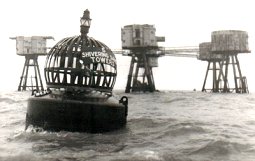

|
 |
|
 |
Reg Calvert,
at the time, operated his business out of 'The Record Centre', 20a Oxford
Street, Whitstable. This was owned by Eric K. Martin, a successful businessman
from a wealthy family of brewers and pub owners that sold out to Shepherd-Neame,
Faversham. He became the Radio Sutch 'station manager' by default, having
responded to an on-air plea for supplies from the Shivering Sands fort by
David Sutch and, as 'Ricky Martin', recorded fill-in programmes sent out
by tender during 1965. During a storm on 17th September 1964 Radio Syd's 'Cheeta I' went adrift and ran aground near Malmö, holed below the waterline. On 19th September the ship was refloated and taken to Malmo for repairs, but sunk there, at Quay 11, under suspicious circumstances during the evening of 7th October 1964. It was suspected that this was done for insurance purposes as all the valuable generation and transmitting equipment had, strangely, already been removed, but nothing was ever proved. By September 1964 David Sutch was getting bored with his radio station and, having been offered a concert tour in Australia and New Zealand, sold his interest to Reg Calvert for a reported £5,000. Calvert bought new equipment and expanded the station into more of its five available towers. |
| Pop music
had started reaching the mainland from a number of unlikely sources and
the most ambitious of these was probably a project started in May by shipbuilder
Cornelius Verolme, which involved the creation of a brand new artificial
island off the coast of Holland. Verolme partnered with Will Hordijk and
Pieter Heerema, a Scheveningen shipping magnate, to make this dream a reality.
Banking organisation Texeira de Mattos financed the venture. The plan was
for the company REM, 'Reklame Exploitatie Maatschoppij' (Advertising Exploitation
Company) to construct the 'island' at Verolme's shipyard in Cork and tow
it from there to a position about six miles off Noordvijk where it was to
be sunk into the sea bed on legs, rather like an oil rig. The structure boasted a 60 metre antenna, a roof that doubled as a helipad and sufficient accommodation to house 25 staff. It was towed into position across the North Sea by Heerema's 'Global Explorer', which had a lift capacity of 300 tons (and was the first vessel in the world to be converted into a floating crane), arriving on 3rd May 1964, closely observed by two Dutch naval vessels who looked on from half a mile away as the seabed support holes were bored 10km off the Dutch coast. This huge undertaking acquired the name 'REM Island' and was to become the home of Radio Nordzee. However, the positioning of the structure proved to be a misjudgement when the Dutch government gained support from neighbouring countries to allow it to extend its territorial waters to 11.5 kilometres, bringing the station within their legal jurisdiction. On June 3rd Radio Invicta made some test transmissions, on a variety of wavelengths, from the Red Sands fort in the Thames Estuary, five miles off Whitstable. They had settled on 390 metres 985kHz by the time they commenced regular broadcasting on July 17th. The station was owned and managed by Tom and Francis Pepper, Charles Evans (who was later ousted from the group) and John Thompson, late of the unsuccessful Voice Of Slough etc. The station was serviced out of Whitstable by the 'Mallard', a fishing vessel owned by Vic Davis, which continued to service the fort throughout its various incarnations. As a point of interest, the Red Sands fort was seen on television at least a couple of times in the Sixties, being used as a filming location for 'Not So Jolly Roger', the last episode of 'Danger Man', starring Patrick McGoohan as British Intelligence agent John Drake. Televised on 7th April 1966, it featured Drake's investigation of a murder on board an offshore pirate radio station called 'Jolly Roger'. It also featured in the Dr. Who 'Fury From the Deep' episodes 5 and 6, shown in April 1968. |
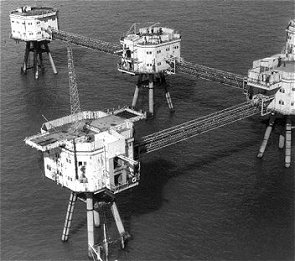 |
Another interesting fact is that all early mail to Radio Invicta received
replies from a department within Polydor records (whose products were also,
later, heavily plugged by King Radio), which suggested that at least some
of the major record companies were taking a much bigger interest and involvement
in the pirate stations than they were prepared to publicly admit to at the
time. Manx Radio made its first tentative test broadcasts from a caravan
studio on June 5th and a rag week stunt by some students from Leeds University
led to an abortive attempt to start an unnamed pirate station from the yacht
'Carmen', off the coast of Harwich, on June 21st. The operating costs of Radio Atlanta and Radio Caroline were not cheap as they both had to be supplied by service boats out of Brightlingsea or Harwich which, after being checked by UK Customs, ferried all their necessary provisions out to them including fuel, water, food, new record releases or recordings and, of course, regular staff changes and replacements. Some way had to be found to reduce costs and it made financial sense for the two stations to amalgamate. Talks between Allan Crawford and Ronan O'Rahilly, which had been more or less ongoing since before either station had gone on air and were hastened by pressure on the government from the music industry to outlaw them, resulted in the merger of Radio Atlanta and Radio Caroline being announced on July 2nd 1964. Radio Atlanta officially ceased to exist at 8pm on that day when the 'Mi Amigo' started transmitting as 'Radio Caroline South' from its existing location off Frinton-on-Sea. The 'Caroline' was moved from her position off Felixstowe to an anchorage off Ramsey, Isle of Man, to cover north-west England, northern and southern Ireland as Radio Caroline North with the station actually continuing to broadcast, as Radio Caroline North, whilst en route, courtesy of the only two DJs on board during the trip, Tom Lodge and Jerry Leighton. A minor curiosity occurred on July 5th when a station identifying itself as 'Radio Free Yorkshire' broadcast fleetingly in the Bridlington area. It was apparently the idea of, and operated by, would-be councillors to show 'the dangers of pirate radio' and possibly holds the distinction of being the shortest-lived transmitting pirate radio station, although there were quite a few other serious contenders for this less than prestigious title. One of these was Radio Red Rose which began broadcasting for a few hours on July 12th from the steamship 'Red Rose', anchored about 20 miles off Liverpool, and was financed by a consortium of Liverpool club owners. The exact duration and fate of this station are unknown but some accounts state that it only lasted the one day. The following day, July 13th, Radio Caroline North commenced broadcasting regular programmes on 197m between 6am and 9pm from its new permanent location off the Isle of Man. Shows included Tom Lodge's 'Rave Party', Jim Murphy's 'Midnite Surf Party' and Don Allen's 'Country & Western Jamboree'. |
| With this
new 'dual attack', Radio Caroline was able to broadcast to most of Britain,
with some programmes being pre-recorded on land and broadcast simultaneously
from both ships. During this period the Radio Caroline company moved out
of the offices that they shared with 'Queen' magazine into 'Caroline House',
a seven-floor building in Chesterfield Gardens, Mayfair, where they had
their own recording studio built. Spare floor space was rented out to The
Moody Blues, Terence Stamp and the Rik Gunnell promotion agency. The company
operated under the name of Project Atlanta for a few months before reportedly
severing all remaining links with Atlanta and becoming Planet Productions
Limited. Radio Noordzee began test transmissions in Dutch on July 19th, initially using 280 metres at 1071kHz, changing to 214 metres at 1400kHz before they began regular transmissions between 9am and 6.15pm on July 29th. They followed this up with test television transmissions in August leading to a regular television service, TV Noordzee, which started on September 1st, triggering more serious debates in the Dutch Parliament. On 28th September a survey announced that Radio Caroline had more listeners than BBC Radio. It was around this time that Radio Veronica moved away from using pre-recorded material and started broadcasting live from their ship, introducing a new top 40 programme format. Also during September, some other short-lived pirate transmissions were heard from Radio Lambay, off the Irish coast, and Radio Shannon which transmitted from the coaster d.s.'Viking'. On 30th September 1964 Reg Calvert used the ex-Radio Sutch facility to start broadcasting under the new name of 'Radio City'. The station could be heard from 6am to midnight on 238 metres at 1261kHz and, apart from the record promotions (they ran a 'new releases' program at 1pm each day) its output continued to be fairly footloose and fancy-free. |
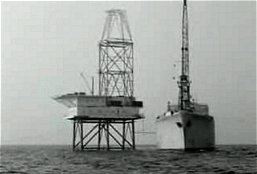 |
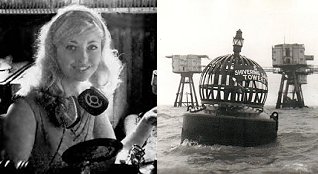 |
Radio City
laid claim to having the first female pirate disc jockeys in Peggy Knight
(Linda Bass) and, possibly even before her, Reg Calvert's daughter, Candy,
who hosted a show called 'Candy's Pop Shop' during the school holidays!
They certainly had the first programme dedicated specifically to the music
of The Beatles and The Rolling Stones, 'The 5 x 4 Show', and also put out
a weekly comedy show called 'The Auntie Mabel Hour' in which Ian MacRae
and Alan Clarke satirised contemporary issues, not unlike the station's
original owner. Broadcasting content was fairly eclectic, with Reg also
taking his turn at broadcasting and, apparently, spending one evening reading
out 'Lady Chatterley's Lover' to his south-east audience! At that time their advertising income was still low compared to other stations so Reg Calvert supplemented this by taking on paid American religious programmes. This was a highly lucrative decision and, by early 1965, Radio City was claiming a monthly income of around £20,000 with running costs of around £2,500. In mid-December their music broadcasts were switched to 290m (but were still announced as 299m) when a more powerful ex-navy transmitter, nicknamed 'Big Bertha', was acquired. The old transmitter (originally from a Handley Page bomber) continued to be used for the sponsored religious programmes, broadcasting on 188m so as not to interfere with the more popular music output. Although output never exceeded 2kW, the efficiency of the antenna combined with its location over water (a reflector of radio waves) gave it the coverage of a more powerful land-based station, and Radio City notoriously claimed a power of 10kW for the purpose of attracting potential advertisers. ' Coded' messages to onshore facilities and suppliers were not unusual. Radio City occasionally broadcast 'You've Got Your Troubles' by The Fortunes as a signal to land-based associates of a problem, such as a supply shortage. Just before taking on the paid religious programmes, Reg Calvert voiced what was probably the strangest idea during the 'pirate radio' era, suggesting that he was considering using a submarine as a radio base! In his words "A submarine is not so crazy as it might sound. It is the only craft capable of remaining in the Thames Estuary which can be tremendously rough. |
| Most of
the time the sub would remain on the surface, but in rough weather we could
easily dive a few fathoms and continue transmission - its 200ft radio mast
would still be above the water. It will be financed from the proceeds of
Radio City. The submarine will only cost about £4,000 to fit out. If we
cannot buy a submarine in this country we will go abroad to find one. There
is nothing to stop us buying one from, say, Belgium. Once the thing is out
of the country no-one can do much about it". November 19th 1964 saw the arrival of Radio London which had set sail from Miami on October 22nd. The ship, converted for broadcasting, had been built in 1944 and was the 780-ton, 185ft former US minesweeper 'Manoula' (also known as 'Density') which had been renamed 'Galaxy'. After anchoring in the Thames Estuary she immediately started test transmissions on 412 metres and 324 metres with a 50kW transmitter, which was potentially about ten times more powerful than Radio Caroline. The ship's captain very quickly received a friendly warning from Ronan O'Rahilly that he had mistakenly situated the vessel inside territorial waters which resulted in them making a slight positional change to their anchorage about three miles off the coast of Frinton-on-Sea, within sight of the 'Mi Amigo'. Following further test transmissions made on December 5th using 265 metres, 277 metres and finally settling on 266 metres, regular programmes began on December 23rd but initially utilised only 17kW of her awesome transmitter power. The first programme was presented by Paul Kaye. In the meantime, Manx Radio, the first legal land-based commercial station, finally went on air officially on November 24th. Radio London, also popularly known as 'Big L', was backed by a consortium of 17 main shareholders, mostly Texan oil people, under the name of Marine Investments Inc. and was headed by Don Peirson who owned the Abilene National Bank and several Dodge and Oldsmobile automobile agencies. Other shareholders included Tom Danaher, who owned Volkswagen automobile agencies and the airport at Wichita Falls, Mal McIlwain, owner of McIlwain Cadillac Company and Ford automobile agencies and Jack McGlothlin who was a Texas oil mogul. Many of the major shareholders sub-divided their holdings amongst smaller investors, allegedly including the US President's wife 'Ladybird' Johnson. |
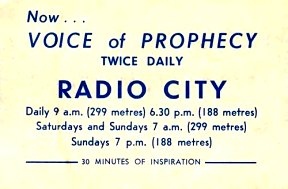 |
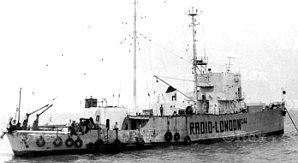 |
This rumour had its grounds in the fact that the station's managing director,
Philip Birch, had been a guest at the Johnson ranch and claimed to have
gained presidential approval for the venture during his stay. Aware of the
success of his local Dallas radio station KLIF, and further impressed by
that of Radio Caroline, Don Peirson planned to bring an American presentation
style to British offshore radio. Peirson's original idea was to broadcast
pre-recorded KLIF tapes under the name of 'Radio KLIF London' with the necessary
changes to the jingles, but the plan was moderated when it occurred to them
that the 'conservative' British listening public might not be attracted
by the upbeat American-style presentation. Sales manager and disc jockey
Ben Toney, who had previously been a director of Fort Worth stations KCUL
and KJIM, was brought in as programme director from the American station
WTAW to produce a format for the new station in association with ex-Radio
Nord man Gordon McLendon. One of their innovations led to Radio London being the first 'British' pirate radio station to carry news bulletins, which were broadcast on the half hour along with a weather forecast. Attempts at affiliation with all the major news services, and even the 'Sun' newspaper, had been unsuccessful due to the potential legal complications of dealing with pirate radio so, ultimately, they merely 'stole' BBC news broadcasts. The format was a mix of top 40 records with an occasional 'golden oldie', overseas hit, new release or LP track thrown in and was known as the 'Fab 40'. Each show was about 3 hours long, containing about 6 minutes of advertising per hour. 'Pirate' radio 'charts' were not, in fact, representative of actual record sales but more of a prediction of what they thought would shortly become popular and were, to some extent, also a 'plug' for certain records on new release. |
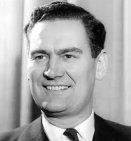 |
|
That month, the 'News
of The World' Sunday newspaper was persuaded to run a trial advertisement
on Radio Invicta by Tom Pepper (Harry Featherbee). The station's senior
disc jockey, DJ Ed Moreno, was to do the voice-over so, on 16th December,
he and Tom Pepper embarked from Faversham on Pepper's launch, the 36ft
'David', to do the adverts out at the Red Sands fort, also taking along
some much-needed food supplies. After unloading Moreno and the cargo,
Pepper headed back towards shore along with two of the station staff,
disc jockey Simon Ashley (Barry Hoy) and 18 year-old engineer Martin Shaw,
who were due to take their Christmas break, but the vessel was hit by
a sudden squall and began to ship water. |
|
Three
tenders were operated out of Holland by a salvage company owned by the Wijsmuller
brothers. The
vessels 'Offshore I' and 'Offshore
2' supplied the ships on the east coast while the larger 'Offshore III'
was capable of making the run to supply Radio Caroline North on the west
coast. Radio Caroline North was also in the happier position of being able
to obtain supplies from Dublin or even the nearby Isle of Man as the Manx
government were reluctant to ratify legislation against the ship due to
the trade and tourism she brought to the island. February found Reg Calvert planning another new radio station and started to consider using the empty fort at Knock John, but that particular site was also keenly sought by Roy Bates, which was to lead to a series of confrontations later that year (also see David St.John's 'The Reg Calvert Story' - great info and some fab, unique pictures). By March 1965 Calvert was also investigating the possibility of acquiring an ex-navy supply boat to start a second radio station and even announced plans for a 'Radio City West' (and a possible TV station - 'City TV' or 'Venture TV', covering south-west England, the south Midlands and south Wales) to be broadcast from a vessel near Lundy Island, just outside the Bristol Channel. This failed to materialise and concentration was then focussed on improving the range of Radio City. In June 1965, after a failed do-it-yourself attempt, professional riggers were employed to erect a new 240ft aerial mast and broadcasting hours were increased to 13 hours a day. During this period one of the Radio City DJs, Tony Carroll, suffered acute appendicitis and had to be airlifted from the station by helicopter. Following the tragic deaths at Red Sands a group of Kent businessmen including Charles Evans (one of the original owners of Radio Invicta), David Lye and John Thompson found new backers and took over the station. |
|
|
At a cost of about
£7,000, new equipment was installed to improve its output and on March
2nd it started test transmissions around 237 metres as King Radio. King
Radio had, apparently, originally been planned as a brand new station
and not as a reincarnation of Radio Invicta, evidenced by the pre-recorded
test broadcasts that gave their location as the Nore tower, which was
somewhat unlikely as the tower had been completely dismantled by the early
Sixties and did not actually exist!. There were some announcements for
planned programmes that included shows called 'South East Special', 'Mardi
Gras', 'Fiesta' and 'Candlelight and Wine', although no such-named shows
were ever broadcast by the station. |
| On April
10th tapes arrived in London for the first ever record company-sponsored
show on pirate radio. American label Roulette Records had signed a two-year
contract with Radio Caroline which included spot advertising and, despite
written objections by E.M.I. who were the U.K. licensee, the shows were
first transmitted on April 12th. Thursday May 13th 1965 saw a station called 'Radio Pamela' start to make test transmissions on land around Colchester with a full service announced to commence on 16th May, 11.00am to 3.00pm on Sundays, but only with a range of about 20 miles, covering Clacton, Harwich, Mersea Island and Colchester. Reg Torr, managing director of TD Television in Clacton came up with the idea of using his service manager's boat, the 18ft 'Pamela', to broadcast from offshore with equipment built by the boat's owner George Short. 'Pamela' would anchor 3.5 miles off the Essex coast each Sunday, close to the Gunfleet Lighthouse, to broadcast pre-recorded tape programme. Their intention was to advertise only their own products but hinted at possible expansion should there be interest from other companies. It was good as a publicity stunt, but with the inherent problems and cost in transmitting the once weekly programmes it was not long before Torr did not want to pursue the project further. |
 |
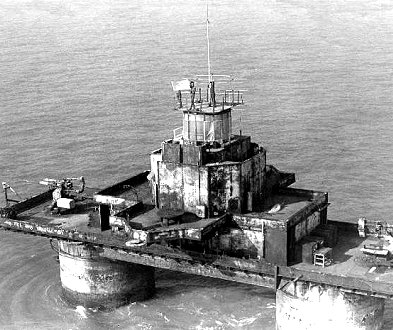 |
George
Short, however, was keen to continue and enlisted the help of local businessman
Eric Sullivan and acquired a slightly more powerful transmitter, an ex-Canadian
Army unit that used just one single 813 output valve. It is alleged that
they contacted Reg Calvert, who declined to become involved as he was already
in planning for Radio Sutch, so they decided to find a tower to transmit
from and eventually selected Roughs. Sullivan, John Waters and a friend hired a boat from Tubby Bennett to visit the tower but were unable to board due to heavy seas. The fort's legs had become damaged over the years, having been hit by a ship in the 1950s, and were flooded, with the water level rising and falling with the tide. Also, Sunk Head was located in deeper water than the other navy forts, with strong tides and generally larger waves making any sort of approach hazardous. Knowledge of their intention to return the following week reached the ear of Caroline's shipping agent, Percy Scaddon, who immediately sent out a group of men to take over the fort on behalf of Radio Caroline. The 'Pamela' plans seemed to be thwarted when they discovered that the only remaining tower, Sunk Head about 11 miles off Clacton, was also occupied by Radio Caroline. However, the men on this fort were taken off after severe storms and, on confirming that it was deserted, John Waters hired Ron Pipe's boat 'Girl Betty' from Burnham-on-Crouch and boarded the structure on 13th October 1965, leaving 'caretakers' John Boulter and Terry Lambeth aboard to 'hold' the fort. This, effectively, was the end of Radio Pamela while equipment and staff were being assembled for the new station, to be called Tower Radio. Press releases at the time advertised that the output of the new £40,000 station (this was predicted operational costs, not capital outlay) would include keep fit classes for housewives, farming, religious, political and general news programmes. Not only that, but there was also to be a television station, called 'Tower TV' that was planned to broadcast American films, thriller series, record programmes and adverts on the Channel 5 frequency. This was already earmarked for the BBC but Tower was going to use the airspace for a few hours after 12.15am when BBC transmissions had ended for the night, broadcasting to coastal areas between Ipswich and Colchester. The television service was originally supposed to start on 9th November (or in the New Year, according to some press reports) but no substantiated views of any transmissions were ever seen. The project was abandoned in January the following year in favour of concentrating on the radio station. In June or July 1965 a local land-based pirate station identifying itself as Radio Shanus (often misquoted as 'Shameless') began broadcasting in the Wimbledon area of London. One of the 'pirates', Martin Macgregor (who also broadcast from Radio Essex as 'Peter Lane' and was involved in Roy Bates' ill-fated attempt to start Radio Kent on Tongue Sands off Margate), confirms "It was actually Radio Shanus … please do not ask why … just the name that a bunch of us came up with". Radio City increased their transmitter power from 3.5kW to 10kW in June and also extended their broadcasting hours. Financial problems for King Radio eventually resulted in an expensive takeover on June 7th 1965 by Ted Allbeury's company, Estuary Radio Limited, who brought in program director Peter James and spent the next couple of months refitting the station at a cost of about £150,000, including installation of an RCA 10kW transmitter and a 297 foot aerial. Not all the towers were in use and one in particular was 'reserved' for the transmitter and technical equipment. |
|
Two
custom-built air-conditioned studios were used, fitted with twin tables,
seven-channel mixers and twin tape recorders. The total power output capability
was some 35kW (although it only normally used about 10kW) and it resumed
transmissions with Glen Miller's 'Moonlight Serenade' on September 22nd
broadcasting on 388.1 metres under the name of 'Radio 390', with such
programmes as 'Eve - The Woman's Magazine of the Air' which was the station's
original planned name. This idea was not followed through due to the fact
that it was not 'snappy' enough and failed to include an advertisement
for its wavelength.
By September 1965 Radio Caroline South had been seeing a decline in its advertising revenue due to the success of Radio London 'Big L' and, with the arrival of another American radio station rumoured, entered into talks with Radio City and Reg Calvert about a possible merger. Through Major William 'Oliver' Smedley of Project Atlanta, Calvert offered to sell Shivering Sands and Radio City but Atlanta were not keen on this due to the financial, staffing and other issues that Caroline South were currently having to contend with. However, a merger proposal whereby Shivering Sands would be used as the Radio Caroline South platform (a fort being much cheaper to operate than a ship) with the 'Mi Amigo' ship to move to a new broadcasting location off either the south-west or north-east coast, where competition would be less intense and costs lower, was agreed. |
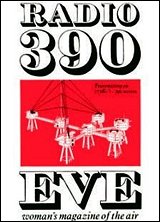 |
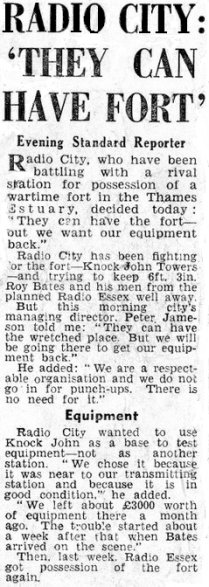 |
A jointly-owned company
was set up to handle advertising sales for both stations and, when the
agreement came into effect on October 1st, regular listeners at the time
would have heard Radio City starting to broadcast Caroline's pre-recorded
'Newsbeat' items and promoting some of the Caroline programmes. As part
of this agreement Project Atlanta director Smedley agreed to finance a
new, more powerful transmitter to relay Caroline's transmissions via the
fort while Radio City owner Calvert ran the day-to-day operations on behalf
of Radio Caroline South. Calvert then used
the Radio City supply boat and a group of ten men to oust these, this
time leaving three men aboard. "The other chaps went moderately quietly
- we promised them safe conduct" said a station spokesman at the time.
A further sortie from Southend by Bates removed these three, transporting
them back to Shivering Sands. |
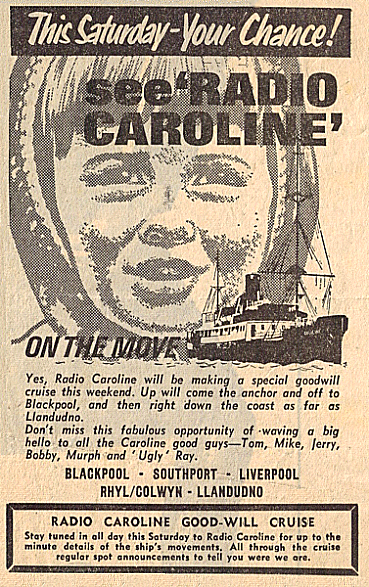 |
|
|
All
Original Material Copyright SixtiesCity
Other individual owner copyrights may apply to Photographic Images |